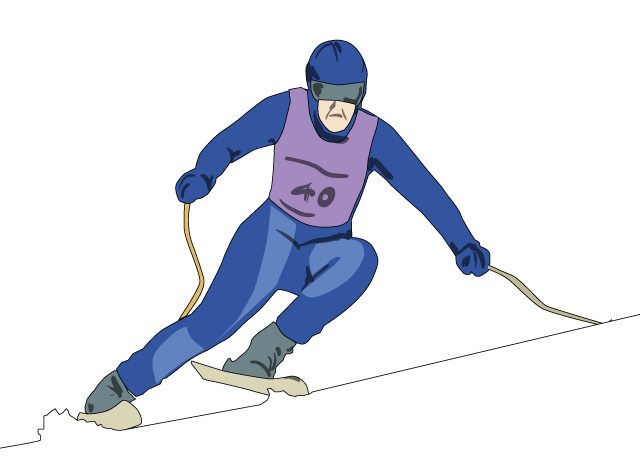Alpine skiing events were held for the first time at the Winter Olympics in 1936, though ski instructors were barred as they were classified as being professionals. This decision led to an Austrian and Swiss boycott, and to the decision not to have skiing events in the next games in 1940. In 1948 at St Moritz, men and women each had three alpine skiing events. Currently there are 11 events.
Events in Beijing 2022
Currently Alpine Skiing includes 11 events - 5 disciplines for men and women: Downhill, Super G, Giant Slalom, Slalom, and Super Combined, plus a mixed team event.
The rules are the same for all events, only the courses differ. The aim of all events is for the skier get down the mountain in the shortest possible time. There is no judging involved and races are timed in hundredths of a second.
There are two 'technical' events (the slalom and the giant slalom), and two 'speed' events (the downhill and super-G) and one combined event, of a slalom and downhill run, where the winner is the skier with the fastest aggregate time.
In the mixed team event is between national teams comprising two men and two women. Starting with 16 teams, they are gradually knocked out after head-to-head races down two identical slalom courses between athletes from each team.
 Trivia
Trivia
- Austrian Franz Klammer won gold in downhill skiing in Innsbruck in 1976.
- The world's youngest Olympic skier was Seba Johnson from the US Virgin Islands. She was aged 14 when she competed in the giant slalom and Super-G at the 1988 winter Olympics in Calgary, Canada. Seba was also the first African-American Olympic skier and the first "black" female Olympic skier in the world.
- Swiss skier Vreni Schneider, whose herniated disk had kept her from winning anything at the previous Games in 1992, won medals in all three alpine skiing events in 1994, bringing her total to five.
- In the 1998 Nagano Games, there was a spectacular "human-cannonball" fall by Austrian Hermann "The Herminator" Maier in the men's downhill. The fall ruined his chances as favorite in the event, but incredibly he got back on his skis again to win gold medals in the Super-G and the Giant Slalom.
- Also at the 1998 Nagano Games, Katja Seizinger of Germany became the first woman to win the downhill gold in successive Olympics, while American Picabo Street shrugged off debilitating injuries to win the gold medal in the Super G.
- At Salt Lake City in 2002, the Croat Janica Kostelic won three golds in the alpine skiing, a triple feat only achieved previously by the greats Toni Sailer and Jean-Claude Killy.
- The 2010 downhill course included sections that were termed: waterfalls, toilet bowl, the weasel, fallaway, the sewer, and coaches’ corner.
- Ghana's first-ever participant at the Winter Olympics, Kwame Nkrumah-Acheampong (nicknamed the 'Snow Leopard'), competed in the men's alpine skiing slalom event, finishing in 47th (2nd last) place.
- The first gold medal tie ever for an Olympic alpine skiing event was in 2014 when two gold medals, one to Slovenia and one to Switzerland, were awarded in the Women's downhill skiing.
- Slovenia's Tina Maze dominated the women alpine skiing in 2014 with two gold medals - she won the Giant Slalom and had a historic dead-heat for first in the Downhill.
Related Pages
- Alpine Skiing Videos
- More Winter Olympics Sports
- Winter Olympics main page.
- About the Skiing World Championships


 Current Events
Current Events